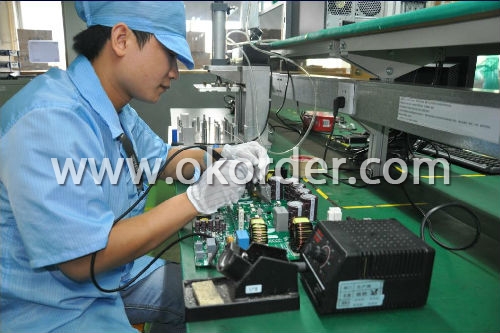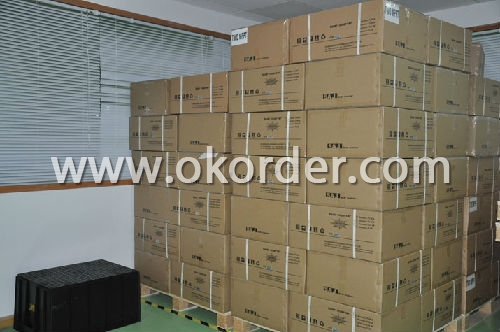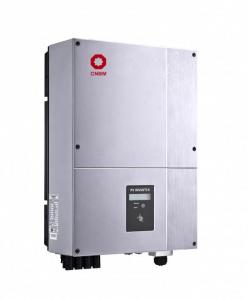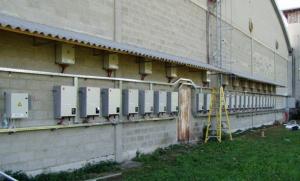Grid Tied Solar Inverter 3-Phase CNBM-10000UE
- Loading Port:
- NanJing
- Payment Terms:
- TT
- Min Order Qty:
- 1 set set
- Supply Capability:
- 1000/month set/month
OKorder Service Pledge
OKorder Financial Service
You Might Also Like
Features of Grid Tied Solar Inverter 3-Phase CNBM-10000UE
CNBM International Corporation (CNBM International) is the most important trading platform of CNBM Group Corporation, a state-owned company under the direct supervision of State-owned Assets Supervision and Administration Commission of the State Council.
With a R&D team more than 100 engineers,40% of the staff, who has been deeply engaged in the photovoltaic industry for 10 years, CNBM takes the mission to increase the inverter availability and efficiency, putting continuous innovation to make CNBM inverter easier for installation and operation, and more cost-effective for solar plant construction. The full range of CNBM single phase inverters has received VDE, CE, G83/1, G59/2, ENEL2010, VDE4105, C10/C11, AS4777 etc.
Maximum efficiency of 97.8% and wide input voltage range, Internal DCswitch,MTL-String, Sound control,Bluetooth/RF technology /WiFiTransformerless,GT topology
The Grid Connected Solar Inverter we can offer is 1.5kw to 20kw.
Introduction of Grid Tied Solar Inverter 3-Phase CNBM-10000UE
Maximum efficiency of 97.8% and wide input voltage range
Integrated DC switch-disconnected
MTL-String
Sound control
Bluetooth/RF technology /Wi-Fi
Transformerless GT topology
5 years warranty (10 years as optional)
Technical data of Grid Tied Solar Inverter 3-Phase CNBM-10000UE
Model | CNBM-10000UE | CNBM-12000UE | |
Input data (DC) |
|
| |
Max. DC power | 10500W | 12500W | |
Max. DC voltage | 1000V | 1000V | |
Start voltage | 350V | 350V | |
PV voltage range | 180V-1000V | 180V-1000V | |
Max. input current | 15A | 17A | |
Number of MPP trackers /strings per MPP tracker | 2/2 | 2/2 | |
Output (AC) |
| ||
Rated AC output power | 10000W | 12000W | |
Max. AC power | 10000VA | 12000VA | |
Max. output current | 16A | 19A | |
Power factor | 1 | 1 | |
THDI | <3% | <3% | |
AC connection | Three phase | Three phase | |
Efficiency |
| ||
Max. efficiency | 98% | 98% | |
Euro weighted efficiency | 97.5% | 97.5% | |
MPPT efficiency | 99.5% | 99.5% | |
Protection devices |
| ||
Output over voltage protection-varistor | yes | yes | |
Ground fault monitoring | yes | yes | |
Grid monitoring | yes | yes | |
General Data |
| ||
Dimensions (W / H / D) in mm | 740/440/235 | 740/440/235 | |
Weight | 41KG | 41KG | |
Operating temperature range | –25°C ... +60°C | –25°C ... +60°C | |
Altitude | 2000m(6560ft) without derating | ||
Self-Consumption night | < 0.5 W | < 0.5 W | |
Topology | Transformerless | ||
Cooling concept | Natural | Natural | |
Environmental Protection Rating | IP65 | IP65 | |
Features |
| ||
DC connection | H4/MC4(opt) | H4/MC4(opt) | |
Display | LCD | LCD | |
Interfaces: RS485/RS232/Bluetooth / RF/Zigbee/Wifi | yes/yes/opt/opt/opt | ||
Warranty: 5 years / 10 years | yes /opt | ||
Certificates and approvals | CE、VDE 0126-1-1、DK5940、G83/1-1、G59/2、RD1663、EN50438、 VDE-AR-N4105、CEI-021、IEC-62109、ENEL-Guide | ||
Grid Tied Solar Inverter 3-Phase CNBM-10000UE is simple national setting of line supply monitoring, Easy country configuration, with Multi-language,display, currently available for most of the countries over the world.With technical creativity and scientific management, the factory established first class R&D and test centers, as well as management and R&D teams comprising of PhDs and masters with overseas qualification.
Figure 1 the application of Grid Tied Solar Inverter 3-Phase CNBM-10000UE

Figure 2 The Stock of Grid Tied Solar Inverter 3-Phase CNBM-10000UE

- Q:Can a solar inverter be remotely monitored and controlled?
- Yes, a solar inverter can be remotely monitored and controlled. Many modern solar inverters are equipped with built-in communication capabilities, allowing them to be connected to a monitoring system or software. This enables users to remotely monitor the performance, efficiency, and power output of their solar inverters, as well as control various settings and parameters. Remote monitoring and control of solar inverters can provide real-time data, fault detection, and even allow for performance optimization, making it easier for owners or operators to manage and maintain their solar energy systems.
- Q:How does a hybrid solar inverter work?
- A hybrid solar inverter works by converting the direct current (DC) power generated by solar panels into alternating current (AC) power that can be used to power household appliances or be fed back into the grid. It also has the capability to store excess energy in batteries for later use during periods of low solar generation or power outages. This allows for efficient utilization of solar energy and provides backup power when needed.
- Q:Can a solar inverter be used with a solar-powered air conditioner?
- Yes, a solar inverter can be used with a solar-powered air conditioner. The solar inverter is responsible for converting the direct current (DC) produced by the solar panels into alternating current (AC) that can be used to power electrical appliances, including air conditioners. By connecting the solar inverter to the solar panels and then to the solar-powered air conditioner, the AC produced by the inverter can be utilized to run the air conditioner, effectively making it solar-powered.
- Q:Can a solar inverter be used with a solar-powered waste management system?
- Yes, a solar inverter can be used with a solar-powered waste management system. A solar inverter is responsible for converting the direct current (DC) produced by solar panels into alternating current (AC) that can be used to power various appliances and systems. In the case of a solar-powered waste management system, the solar inverter would ensure that the electricity generated by the solar panels is compatible with the system's components, such as motors, sensors, and controls. This would enable the waste management system to operate efficiently using clean and renewable solar energy.
- Q:Can a solar inverter be used with solar-powered recreational vehicles (RVs)?
- Yes, a solar inverter can be used with solar-powered recreational vehicles (RVs). A solar inverter converts the DC (direct current) energy generated by solar panels into AC (alternating current) energy that can be used to power various appliances and devices in an RV. This allows RV owners to utilize solar energy for their electrical needs while on the road.
- Q:What is the role of a power factor controller in a solar inverter?
- The role of a power factor controller in a solar inverter is to regulate and optimize the power factor of the inverter's output. It ensures that the power drawn from the grid or generated by the solar panels is in sync with the voltage and current, minimizing reactive power and maximizing the efficiency of the system. By maintaining a high power factor, the power factor controller helps reduce energy losses, improve overall system performance, and comply with grid regulations.
- Q:What are the potential risks of short-circuiting a solar inverter?
- Short-circuiting a solar inverter can pose several potential risks. Firstly, it can cause damage to the inverter itself, leading to its malfunction or complete failure. Secondly, it can result in overheating of the inverter, which may increase the risk of fire or electrical hazards. Additionally, short-circuiting can disrupt the flow of electricity, potentially causing damage to other connected equipment or appliances. Lastly, it may void the warranty of the solar inverter, resulting in additional expenses for repairs or replacements. Therefore, it is crucial to take proper precautions and avoid short-circuiting the solar inverter to ensure its safe and efficient operation.
- Q:How does a solar inverter handle low light conditions?
- A solar inverter handles low light conditions by intelligently adjusting its operating parameters to maximize power output from the available sunlight. It may use techniques such as maximum power point tracking to optimize energy conversion efficiency and ensure that even in low light conditions, the solar panels are generating the maximum power possible.
- Q:Can a solar inverter be used off-grid?
- Yes, a solar inverter can be used off-grid. In fact, off-grid solar systems often require a solar inverter to convert the DC power generated by solar panels into AC power that can be used to power appliances and devices.
- Q:What is the role of a power optimizer in a solar inverter?
- The role of a power optimizer in a solar inverter is to maximize the energy output of each individual solar panel by constantly monitoring and optimizing its performance. It ensures that each panel operates at its maximum power point, regardless of shading, dirt, or other factors that may affect the overall system performance. By individually optimizing each panel, a power optimizer can significantly increase the overall energy production of a solar system.
1. Manufacturer Overview |
|
|---|---|
| Location | Hefei,China |
| Year Established | 2004 |
| Annual Output Value | Above US$0.6 billion |
| Main Markets | Australia;Italy;Germany;U.K. England;Franch;NewZealand; |
| Company Certifications | Growatt5000;VDE0126;SAA;G83;TUV |
2. Manufacturer Certificates |
|
|---|---|
| a) Certification Name | |
| Range | |
| Reference | |
| Validity Period | |
3. Manufacturer Capability |
|
|---|---|
| a)Trade Capacity | |
| Nearest Port | Shenzhen |
| Export Percentage | 0.4 |
| No.of Employees in Trade Department | 10 People |
| Language Spoken: | English;Chinese;French;German |
| b)Factory Information | |
| Factory Size: | Above 15,000 square meters |
| No. of Production Lines | Above 5 |
| Contract Manufacturing | OEM Service Offered;Design Service Offered |
| Product Price Range | Average |
Send your message to us
Grid Tied Solar Inverter 3-Phase CNBM-10000UE
- Loading Port:
- NanJing
- Payment Terms:
- TT
- Min Order Qty:
- 1 set set
- Supply Capability:
- 1000/month set/month
OKorder Service Pledge
OKorder Financial Service
Similar products
New products
Hot products
Hot Searches
Related keywords































